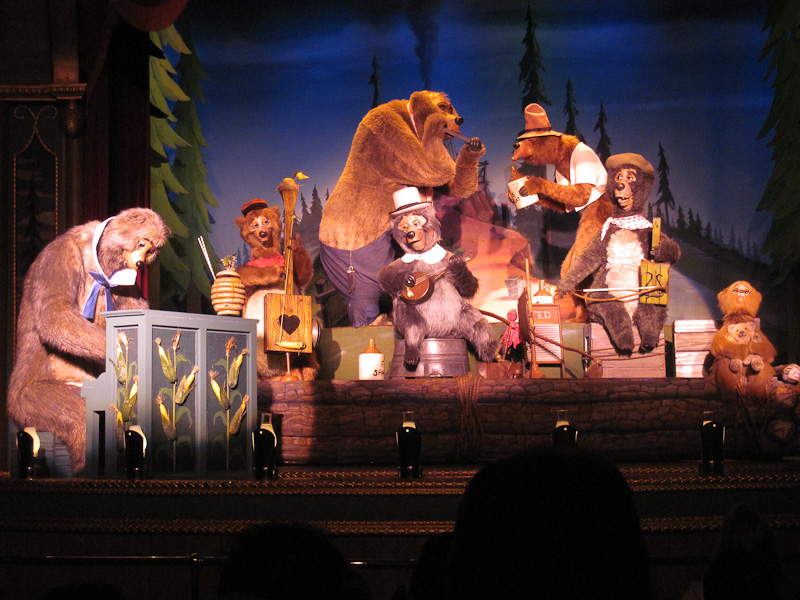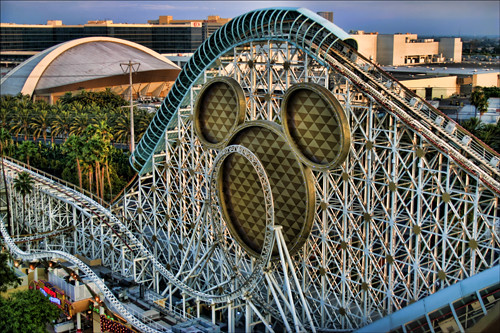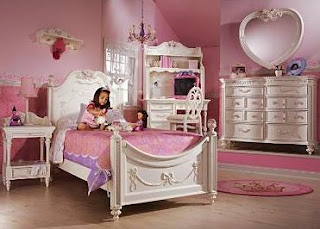Tampa Bay Online: Standing in the spooky darkness of the Haunted Mansion, Paul and Sherrye Archer wait their turn to enter the Magic Kingdom attraction at Walt Disney World.
The mansion filled with ghoulish illusions has been one of the Archers' favorite spots inside the park for the 19 years they have owned season passes. Disney World is the Valrico couple's escape from the pressure of their teaching jobs. Only an hour's drive from their front door, the four parks serve as weekend getaways several times a year.
Their set-in-concrete routine for every Magic Kingdom visit: a beeline to Adventureland and the Splash Mountain ride — their favorite — followed by the rib-rumbling Big Thunder Mountain Railroad. Then the mansion, lunch, a dessert and the Buzz Lightyear laser shooting gallery.
Inside the mansion's dark entrance lobby, a narrator speaks in a mortician's ominous monotone. Sherrye, 61, whispers the script word-for-word. "Your cadaverous pallor betrays an aura of foreboding, almost as though you sense a disquieting metamorphosis. Is this haunted room actually stretching? Or is it your imagination?"
Ah, imagination. The foundation upon which Walter Elias Disney built his entertainment empire. It was imagination that brought a whistling Mickey Mouse to the movie screen, then to TV and then to a land named after Disney in Anaheim, Calif. And it was imagination that led Disney to buy 30,000 acres of mosquito-choked scrubland in the middle of Florida with the idea of building a themed resort where visitors could spend money on rides, in restaurants and at hotels, immersed in a world of his creation.
It would take a Disney-size imagination to ponder what Orlando and Florida would be like if that first shovel of dirt hadn't been turned to build the Magic Kingdom. As the park marks its 40th year in business Saturday, it maintains its spot as the most popular theme park in the world, with an estimated 17 million visitors a year who spill into Orlando and use it as an entry point for exploring the rest of the peninsula.
"You're talking about the 500-pound gorilla in terms of tourism," said Mark Bonn, a professor at Florida State University's College of Business and president of Bonn Marketing Research. "Historically, we were promoted as a sun and sand and ski destination," Bonn said. "That all changed in a hurry when the Magic Kingdom opened."
Bonn's company has been tracking visitors for the city of Tampa for 17 years. His numbers show that 20 percent of the tourists who visit Tampa and St. Petersburg come here because of Disney and the other Orlando attractions it paved the way for. "If you were to take away 20 percent of spending in Hillsborough County, it would be a devastating loss," Bonn said. "Disney was the engine that started it all."
There are stories about why Walt Disney chose to build a duplicate park in Florida. One often-told tale is that Disney saw an employee, or "cast member," dressed in cowboy garb strolling through the futuristic Tomorrowland at Disneyland. For the big-picture Disney, who framed the construction of Disneyland with a cinematographer's eye, the contrast ruined his intended illusion. A theme park built properly would have tunnels for cast members to move without being seen, an innovation he used at Magic Kingdom.
The other story mixes illusion with money: When Disneyland was built outside Anaheim, Disney didn't anticipate the hoards of stores and rundown hotels it would attract outside the gates. As they surrounded the park, it limited any chance to expand. "He wanted them to be immersed and not see a 7-Eleven outside the gates of the Magic Kingdom," said Matt Roseboom, owner and publisher of Orlando Attractions Magazine. "He bought enough land to do just that."
After scouting other places in the United States and within Florida, Disney started scooping up land through dummy corporations to keep prices low. The Florida Project, as he called it, was intended to build Progress City, a concept that became Epcot and the town of Celebration.
Florida was all about big projects then. An hour away, billions of dollars were being spent to launch men into space at Cape Canaveral. In 1962, the nearby Kissimmee River was being straightened and drained to make way for grazing land and agriculture. In 1964, the U.S. Army Corps of Engineers began digging the Cross Florida Barge Canal to give ships a shortcut between the Atlantic Ocean and the Gulf of Mexico.
"When you think about that time frame in Florida, you had a climate that was conducive to having a year-round operation like they had in California," Disney historian Dave Herbst said. "And they had the ability to buy a lot of land at a manageable price."
Using its considerable lobbying power, the company negotiated with the state to grant it eminent domain over the property to avoid the red tape of building in Osceola and Orange counties. The Reedy Creek Improvement District — overseen, managed and policed by Disney officials — was created. After Disney died from cancer in 1966, his brother Roy took over the project, nudging it toward a first phase of construction that included the Magic Kingdom, the Contemporary and Polynesian resorts, golf courses, a campground and a monorail.
When Lakeland residents William "Bill" Windsor Jr. and his wife, Marty, were picked from the opening day crowd of 10,000 visitors to be the first to see Magic Kingdom, along with their toddler sons Jay and Lee, there was no way to predict the park's explosive growth. That 43-square-mile property now consists of four theme parks, two water parks, 33 resorts and hotels, a shopping district, a sports complex and a boardwalk. There remains ample room for parks and resorts if demand grows. Its success spawned similar versions in France and Japan.
So large was Disney's economic gravity back then that SeaWorld duplicated its San Diego theme park with an Orlando version in 1973. Universal Orlando more closely mimicked the Disney model in 1990, with what later became multiple parks and resorts. The three cemented the region as the world's top tourist destination.
A Disney-commissioned study released in April estimates that the Disney property generates $18.2 billion in annual economic activity in Florida, totaling 2.5 percent of the state's gross domestic product. The study by Arduin, Laffer & Moore Econometrics showed Disney employs 62,000 who earn an aggregate of $1.8 billion. Statewide, 160,000 jobs lead back to Disney: one out of every 50 jobs in Florida. That doesn't include the millions of dollars that have flowed to Tampa or St. Petersburg as travelers filter through. Or the construction workers that built houses and widened Interstate 4 and Florida's Turnpike.
Disney and Florida have become so synonymous that marketing money spent by the company to draw visitors acts as de facto promotion for the rest of the state, economist Bonn said. The state has a $25 million tourism marketing budget, while Disney spends $250 million to promote its attractions.
Without Cinderella's Castle, there's no reason to assume Orlando would be the 29th-busiest airport in the world, according to Airports Council International. There's nothing to suggest "the I-4 corridor" would have become so coveted in national politics. "There would be no Orlando Magic basketball team," Bonn said, joking. "Funny how they got that name, eh? What would they have called them, the Orlando Oranges?"
Roseboom recently broke the news in his attractions magazine that Disney plans to feature a land in its Animal Kingdom park dedicated to "Avatar," the largest-grossing movie ever.
Without the Magic Kingdom, Herbst never would have left his job as a sports copy editor for the Pittsburgh Press to become a Disney historian. He will retire this year after 30 years. In 1977, he begrudgingly took a trip to Magic Kingdom instead of visiting his grandmother.
"My friends loved Disney," Herbst said. "They said, 'You have to go to Walt Disney World.' My response was, "Why? We have Kennywood!' "
After two days in the Magic Kingdom, he told his wife while driving north on Interstate 95, "I'm going to work there someday.
"I was seeing myself as the guy on the horse-drawn trolley or some fun little job," Herbst said. "I immediately sent a crazy letter to them after we got home. I got back a letter that said, 'Thank you for your interest.'"
Four years later, he was a cast member.
Paul Archer worked as a cast member in the mid-1970s, sweeping up trash along Magic Kingdom's impeccably clean Main Street U.S.A. His favorite park is Epcot: Once you have swept up after the horses, it changes your view of Magic Kingdom, he said. Archer, 55, owns no Mickey Mouse-adorned apparel. His wife once bought them matching Mickey Mouse outfits during a Disney cruise. He wore it. "Once," he said, flatly.
The couple, who met as physical education teachers and coaches at schools in Palm Bay, spend thousands of dollars a year at the park. Married for more than 20 years, they have no children but enjoy seeing the parks through the eyes of their relatives' kids.
Paul, a physical education teacher at Corpus Christi Catholic School in Temple Terrace, runs the Disney Marathon each year through the streets of the theme parks and resorts. Sherrye, who teaches physical education at Stowers Elementary in Lithia, wears her oversized Minnie Mouse hand to wave goodbye to students at the end of the school year. They rarely buy souvenirs.
One time in 2005, they broke that rule. They got through the front gate of Magic Kingdom at opening time and ran to their beloved Splash Mountain. As the first two riders of the day, they went down the water toboggan alone. Twice. They plunked down $15 for the 5- by 8-inch souvenir photo. It sits in a frame on their mantel. "That was the best day at the park ever," she said. "I'll never forget that."
Not everyone has been entranced by Disney's magic, though. Members of the I Hate Disney World page on Facebook, for example, see the resort as "a blight on the fetid swampland it was built on."
"It makes your average refugee camp look like a garden party," the page says. "The most accursed place on Earth."
In 2008, Newark Star-Ledger parenting columnist Peggy O'Crowley bemoaned a trip to Magic Kingdom, confessing her boredom and saying her kids were equally underwhelmed. "The heat, the long lines for rides, the $5 hot dogs, the plastic castle, the adults wearing Goofy or Mickey ears … it was all too much for us," she wrote.
Disney fans swarmed to the newspaper's website to defend the resort. "I am guessing if there was one of the seven dwarfs you admire and resemble the most it would be Grumpy," one wrote.
The definitive anti-Mouse screed remains Miami Herald columnist Carl Hiaasen's 83-page book, "Team Rodent: How Disney Devours the World." Published in 1998, the book has become the Rosetta stone for despising the Disneyfication of Florida and the country.
Hiaasen attacks the company for what he sees as its manhandling of the Legislature to get its way, for destroying the environmental purity of Central Florida and for insisting that nature is something to be managed instead of nurtured.
"Disney is so good at being good," Hiaasen writes, "that it manifests an evil; so uniformly efficient and courteous, so dependably clean and conscientious, so unfailingly entertaining that it's unreal, and therefore is an agent of pure wickedness. Imagine promoting a universe in which raw Nature doesn't fit because it doesn't measure up."
Disney has responded to critics with efforts to tout its recycling efforts. Visitors staying at resort hotels are asked to conserve towels to reduce water use. Attractions at Animal Kingdom and Epcot tout the wisdom of being ecologically minded.
But even critics know Disney isn't leaving Florida anytime soon. Consider those big projects that emerged about the time Magic Kingdom was built. NASA this year stopped sending people into space from Cape Canaveral. The Kissimmee River straightening is being undone to rectify damage to the region and to the Everglades. The uncompleted barge canal didn't see the end of the first Nixon administration and is now a greenway named for its most strident opponent.
Magic Kingdom, on the other hand, will add a village of new princess-themed attractions to Fantasyland next year. And Disney Chief Financial Officer Jay Rasulo announced Thursday the company's plan to expand into India. Shanghai Disney is slated to open in 2015.
Disney endures.
 Inside the Magic: Given its emphasis on future technology, it’s no surprise that Walt Disney World has chosen its Epcot theme park as the location to use a new ticket entry system. Testing began (Sunday) on an RFID based system that requires no turnstiles to enter the theme park. Guests instead simply place a chip-equipped ticket up to a Mickey Mouse-themed device and after a quick finger scan, a green light lets them know they can proceed into the park.
Inside the Magic: Given its emphasis on future technology, it’s no surprise that Walt Disney World has chosen its Epcot theme park as the location to use a new ticket entry system. Testing began (Sunday) on an RFID based system that requires no turnstiles to enter the theme park. Guests instead simply place a chip-equipped ticket up to a Mickey Mouse-themed device and after a quick finger scan, a green light lets them know they can proceed into the park.














